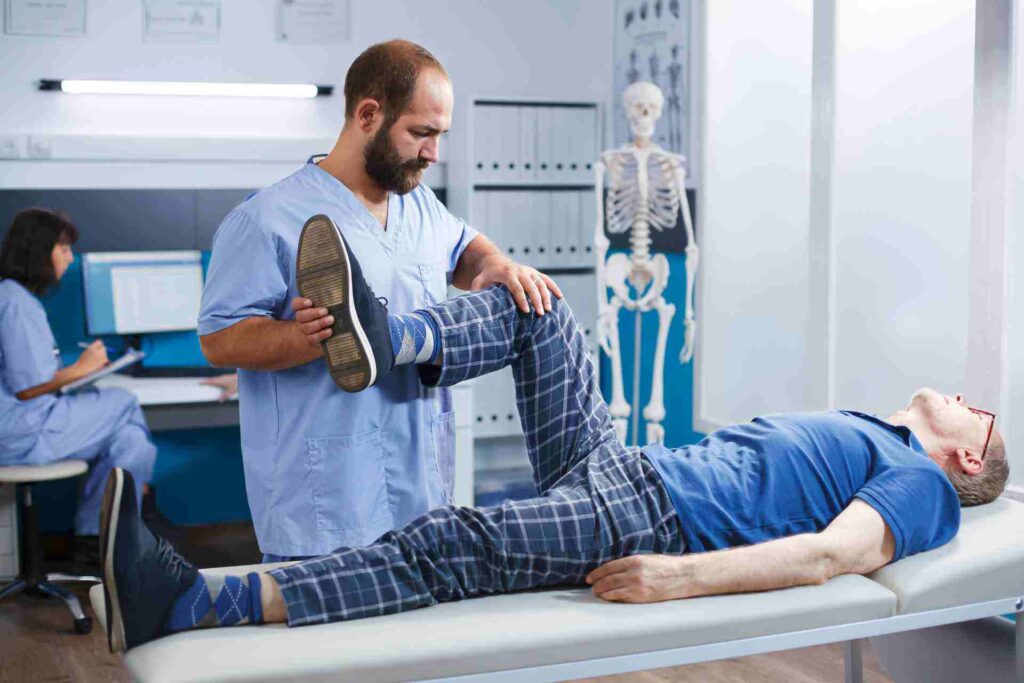 Car accidents lead to a wide range of injuries, and among the most common are those affecting the legs. The force and impact of a collision can cause significant trauma to the lower extremities, leading to various injuries ranging from minor bruising to broken bones. Understanding these injuries, their symptoms, and when to seek medical attention is crucial for prompt and effective treatment. Let’s explore the five most common leg injuries sustained in car accidents and discuss when it’s essential to see a car accident doctor near you.
Car accidents lead to a wide range of injuries, and among the most common are those affecting the legs. The force and impact of a collision can cause significant trauma to the lower extremities, leading to various injuries ranging from minor bruising to broken bones. Understanding these injuries, their symptoms, and when to seek medical attention is crucial for prompt and effective treatment. Let’s explore the five most common leg injuries sustained in car accidents and discuss when it’s essential to see a car accident doctor near you.
5 Most Common Car Accident Leg Injuries
From rear-end collisions to multi-car pileups, car accident leg injuries can happen to anyone. Here are some of the most common leg injuries from car accidents:
Fractures
Fractures are among the most common leg injuries in car accidents, occurring when the powerful force of the wreck puts too much pressure on the legs. Leg fractures can involve the bones in the upper or lower legs, knees, or feet. Symptoms of a fracture may include intense pain, swelling, deformity, and difficulty bearing weight on the affected leg. In severe cases, the fracture may pierce the skin, leading to an open or compound fracture, which also poses a higher risk of infection. It’s important to seek immediate medical attention right away for suspected fractures to prevent further complications and ensure proper alignment and healing.
Sprains and Strains
The sudden impact of a car accident can cause the ligaments, tendons, and muscles in the legs to stretch or tear, resulting in sprains and strains. Ankle sprains are particularly common, occurring when the foot twists forcefully upon impact. Symptoms may include pain, swelling, bruising, and difficulty moving the affected joint. While mild sprains and strains may improve with rest, ice, compression, and elevation, more severe cases may require treatment and physical therapy to support a full recovery and prevent chronic issues.
Knee Injuries
The knee is highly vulnerable during car accidents, often leading to injuries like ligament tears, meniscus tears, or patellar fractures. These injuries can lead to instability, pain, swelling, and limited range of motion in the area. Depending on the severity of your injury, knee injuries may need conservative treatment using a brace, or surgical intervention to repair damaged structures and restore function. Ignoring knee injuries or delaying treatment can result in long-term complications, including arthritis and mobility issues.
Contusions and Hematomas
Blunt force trauma in car accidents can cause contusions, which are deep bruises that can also put you at greater risk for hematomas (blood clots) in the legs. While contusions typically show up as discoloration, swelling, and tenderness, hematomas may present as a firm, painful lump beneath the skin. In most cases, contusions and hematomas resolve with time and conservative measures like rest, ice, and elevation. However, large or painful hematomas may require medical evaluation to rule out complications like cutting off blood flow and causing tissue damage.
Soft Tissue Injuries
Beyond fractures and sprains, car accidents can cause various soft tissue injuries to the legs, including lacerations, abrasions, and deep tissue contusions. These injuries may result from direct impact with vehicle components or objects within the car. While minor soft tissue injuries can often be managed with wound care and pain management at home, deeper wounds at risk of infection should be evaluated by a car accident doctor. Proper wound care, including cleaning, disinfection, and, if necessary, stitches, reduces the risk of complications and promotes healing.
Different Types of Broken Bones
Did you know that when we talk about fractures and broken bones, we’re actually referring to the same thing? Whether you call it a fracture or a broken bone, it means there’s been some sort of injury causing a crack or break in the bone. Understanding the main types of fractures can help you recognize these car accident leg injuries more effectively. Here are the main types of fractures:
Closed Fracture (Simple Fracture)
A closed fracture occurs when the broken bone does not penetrate the skin. The bone may be partially or completely fractured, but there is no open wound. Symptoms include pain, swelling, bruising, and possibly deformity at the site of the fracture. Treatment typically involves immobilization with a cast, splint, or brace to allow the bone to heal properly.
Open Fracture (Compound Fracture)
An open fracture occurs when the broken bone breaks through the skin, exposing it to the external environment. Open fractures carry a higher risk of infection because the bone is no longer underneath the skin’s protective barrier. Symptoms include severe pain, visible wound with bone protrusion, bleeding, swelling, and possible nerve or blood vessel damage. Immediate medical attention is crucial to clean the wound, control bleeding, and prevent infection. Treatment may involve surgery to clean the fracture site, repair soft tissue damage, and stabilize the bone with internal fixation.
Stress Fracture
A stress fracture is a tiny crack or hairline fracture in the bone caused by repetitive stress or overuse. Stress fractures commonly occur in weight-bearing bones like the shin or metatarsals in the foot. Symptoms may include localized pain, swelling, tenderness, and worsened discomfort during activity. Treatment typically involves rest, activity modification, and a gradual return to activity once the bone has healed. In severe cases, immobilization with a cast or boot may be necessary to promote healing.
Comminuted Fracture
A comminuted fracture occurs when the bone is broken into multiple fragments or shattered into several pieces. This type of fracture often results from significant trauma, such as a car accident. Symptoms vary depending on the severity and location of the fracture but may include intense pain, deformity, swelling, and instability. Treatment may involve surgical intervention to realign and stabilize the bone fragments using screws, plates, or rods. In some cases, bone grafting may be necessary to promote proper healing.
When to See a Doctor for Car Accident Leg Injuries
 Knowing when to seek medical attention for leg injuries from car accidents is crucial for ensuring recovery and preventing long-term complications. If you’ve been in a car accident, it’s important to seek prompt medical evaluation if you experience:
Knowing when to seek medical attention for leg injuries from car accidents is crucial for ensuring recovery and preventing long-term complications. If you’ve been in a car accident, it’s important to seek prompt medical evaluation if you experience:
- Severe pain or swelling in the leg
- Inability to bear weight or move the leg normally
- Visible deformity or misalignment of the leg or joint
- Numbness, tingling, or weakness in the leg
- Signs of infection, such as redness, warmth, or drainage from a wound
Leg injuries are common consequences of car accidents, ranging from minor bruises to severe fractures and soft tissue damage. Prompt assessment and appropriate medical care are essential for managing these injuries effectively and minimizing long-term complications. At AICA Orthopedics in Conyers, our team of car accident doctors is here to help you recover from your injuries.
